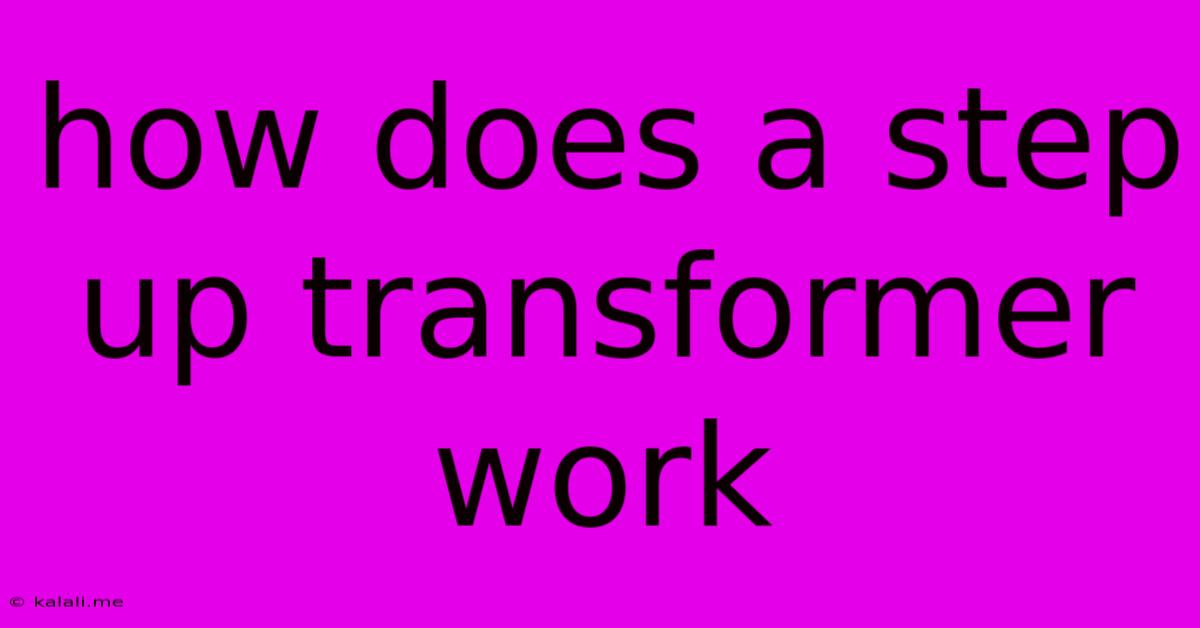How Does A Step Up Transformer Work
Kalali
May 19, 2025 · 3 min read

Table of Contents
How Does a Step-Up Transformer Work? Boosting Voltage for Efficient Power Transmission
A step-up transformer is a crucial component in many electrical systems, playing a vital role in efficiently transmitting power over long distances. Understanding its inner workings is key to appreciating its importance in modern electrical infrastructure. This article will explain the fundamental principles behind how a step-up transformer increases voltage, highlighting its key components and applications.
What is a Step-Up Transformer?
A step-up transformer is a type of electrical transformer that increases the voltage of an alternating current (AC) power supply. It achieves this by having a higher number of turns in the secondary coil compared to the primary coil. This seemingly simple difference in winding configuration allows for the voltage transformation, a process essential for reducing power loss during transmission. Think of it as a voltage booster, making electricity travel further with less energy wasted.
Key Components and their Roles:
- Primary Coil: This is the coil connected to the input AC power source. The number of turns in this coil determines the input voltage level.
- Secondary Coil: This coil is where the stepped-up voltage is produced. It has significantly more turns than the primary coil.
- Core: The core is usually made of laminated iron, providing a low-reluctance path for the magnetic flux. This ensures efficient transfer of energy between the primary and secondary coils. The core material minimizes energy loss through eddy currents.
- Insulation: Proper insulation is crucial to prevent short circuits and ensure safe operation. Each coil is insulated from the core and from each other.
The Principle of Electromagnetic Induction:
The operation of a step-up transformer relies on the principle of electromagnetic induction. When an alternating current flows through the primary coil, it generates a fluctuating magnetic field in the core. This fluctuating magnetic field then induces a voltage in the secondary coil. The magnitude of the induced voltage in the secondary coil is directly proportional to the ratio of the number of turns in the secondary coil to the number of turns in the primary coil.
Voltage Transformation Ratio:
The voltage transformation ratio is defined as:
Vs / Vp = Ns / Np
Where:
- Vs = Secondary voltage
- Vp = Primary voltage
- Ns = Number of turns in the secondary coil
- Np = Number of turns in the primary coil
This formula highlights the direct relationship between the number of turns and the voltage increase. A higher Ns/Np ratio results in a greater voltage step-up.
How it Works Step-by-Step:
- AC Input: An alternating current is applied to the primary coil.
- Magnetic Field Generation: The AC current creates a continuously changing magnetic field in the core.
- Magnetic Flux Linkage: This changing magnetic field links with the secondary coil.
- Voltage Induction: The changing magnetic flux induces an electromotive force (EMF) in the secondary coil.
- Voltage Step-Up: Because the secondary coil has more turns, the induced voltage (Vs) is higher than the input voltage (Vp).
Applications of Step-Up Transformers:
Step-up transformers find widespread applications in various sectors including:
- Power Transmission: Increasing voltage for long-distance transmission minimizes power loss. Higher voltage means lower current for the same power, reducing resistive losses (I²R losses).
- High-Voltage Electrical Appliances: Some industrial equipment and specialized appliances require high voltage for their operation.
- Power Supplies: Certain power supplies use step-up transformers to generate high voltages needed for specific circuitry.
Conclusion:
Step-up transformers are essential components in modern electrical systems. Their ability to efficiently increase voltage is crucial for long-distance power transmission and various high-voltage applications. By understanding the principles of electromagnetic induction and the role of the transformer's components, we can appreciate their vital contribution to our electrical infrastructure. This efficient voltage boosting technology continues to play a significant role in ensuring reliable and efficient power delivery across the globe.
Latest Posts
Latest Posts
-
Did Top Gear Really Discover The Source Of The Nile
May 19, 2025
-
How Much Caffeine In A Teaspoon Of Coffee
May 19, 2025
-
How To Prepare Cockles For Cooking
May 19, 2025
-
How Many Cards Are In A Deck Pokemon
May 19, 2025
-
Love The Bones Of You Meaning
May 19, 2025
Related Post
Thank you for visiting our website which covers about How Does A Step Up Transformer Work . We hope the information provided has been useful to you. Feel free to contact us if you have any questions or need further assistance. See you next time and don't miss to bookmark.